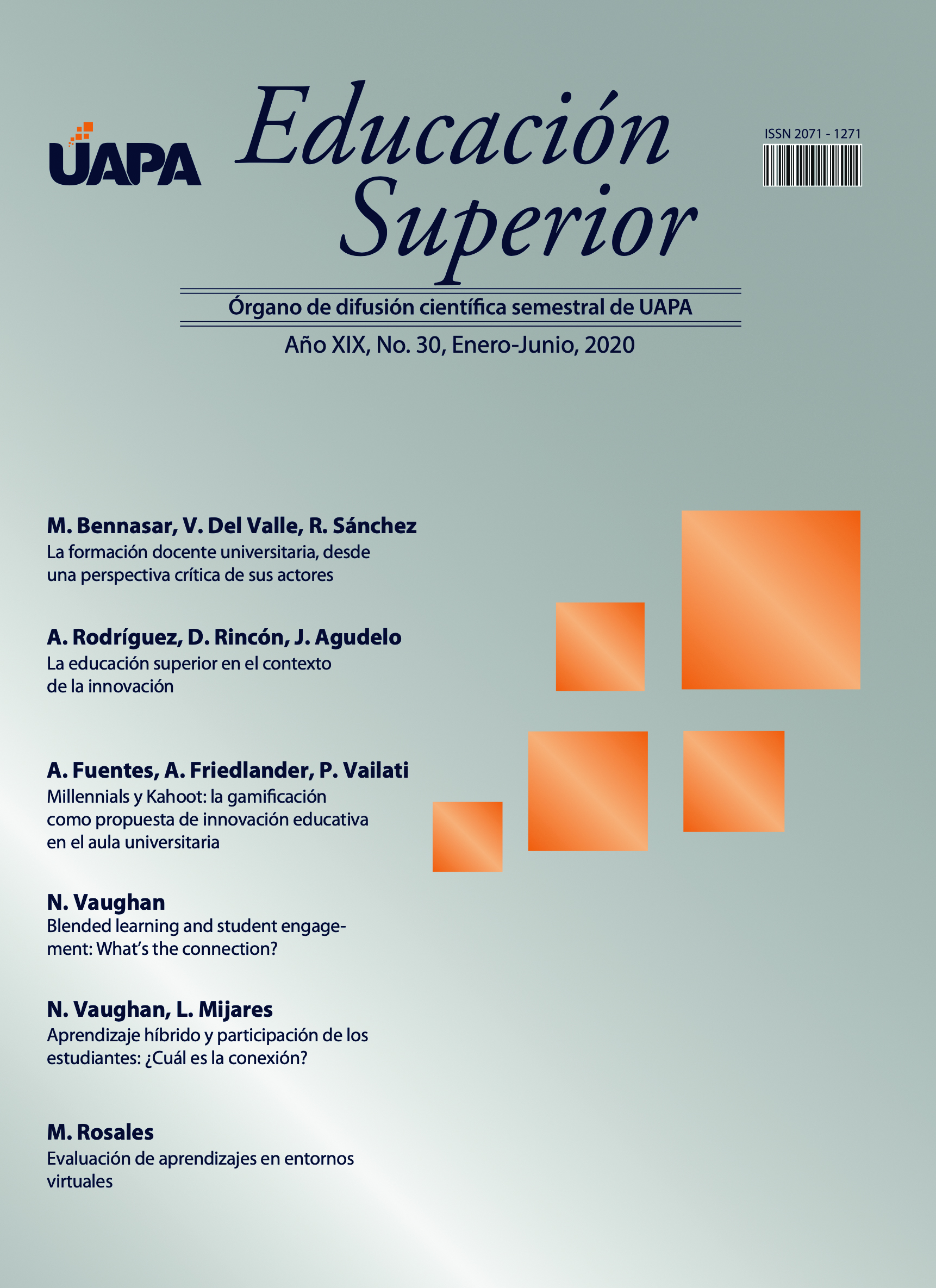Student Engagement and Blended Learning: What’s the connection?
Compromiso de los estudiantes y aprendizaje combinado: ¿Cuál es la conexión?
DOI:
https://doi.org/10.56918/es.2020.i30.pp79-96Palabras clave:
blended learningResumen
This article investigates the connection between student engagement and blended learning through the lens of community of inquiry framework (Garrison, 2017). An introduction to student engagement and blended learning are provided followed by an overview to the community of inquiry model. From this framework, seven principles have been derived to design, facilitate, and direct a blended learning approach to teaching and learning.Descargas
Citas
Allen, I. E., & Seaman, J. (2010). Class differences: Online education in the United States, 2010, Babson Survey Research Group, The Sloan Consortium. Available online at: https://secure.onlinelearningconsortium.org/publications/survey/class_differences
Alton-Lee, A. (2003). Quality teaching for diverse students in schooling: Best evidence synthesis June 2003. Wellington, New Zealand: Ministry of Education.
Arabasz, P., Boggs, R. & Baker, M. B. (2003). Highlights of e-learning support practices. Educause Center for Applied Research Bulletin, 9.
Bleed, R. (2001). A hybrid campus for a new millennium. Educause Review, 36 (1). 16-24.
Chickering. A.W. & Gamson, Z.F. (1999). Development and adaptations of the seven principles for good practice in undergraduate education. New Directions for Teaching & Learning. 80, 75-82.
Clark, D. (2003). Blend it like Beckham. Epic Group PLC.
Csikszentmihalyi, M. (1990). Flow: The psychology of optimal experience. New York: Harper and Row.
Dziuban, C., Graham, C. & Picciano, A.G. (2013). Research perspectives in blended learning: 2nd Edition. New York, NY: Routledge, Taylor and Francis.
Fullan, M. (2012). Stratosphere. Toronto: Pearson Canada
Garnham, C. & Kaleta, R. (2002). Introduction to hybrid courses. Teaching with Technology Today, 8 (6). Available online at:
https://www.wisconsin.edu/systemwide-it/download/ttt.zip
Garrison, D. R. (2017). E-Learning in the 21st century: A framework for research and practice (3rd Edition). London: Routledge/Falmer.
Garrison, D. R., & Vaughan, N. D. (2008). Blended learning in higher education. San Francisco: Jossey-Bass.
Garrison, D. R., Anderson, T., & Archer, W. (2001). Critical thinking, cognitive presence, and computer conferencing in distance education. American Journal of Distance Education, 15(1), 17-23.
Graham, C. R. (2006). Blended learning systems: Definitions, current trends, and future directions. In Bonk, C. & Graham, C. (Eds), The handbook of blended learning: Global perspectives, local designs (pp. 3-21). San Francisco, CA: Pfeiffer.
Hattie, J. & Yates, G.C.R. (2014). Visible learning and the science of how we learn. New York, NY: Routledge.
Lipman, M. (1991). Thinking in education. Cambridge University Press: New York.
Littky, D. & Grabelle, S. (2004). The big picture: Education is everyone's business. Alexandria, VA: Association for Supervision and Curriculum Development.
Littlejohn, A., & Pegler, C. (2007). Preparing for blended e-Learning: Understanding blended and online learning (Connecting with E-learning). London: Routledge.
Mayadas, F. A. & Picciano, A. G. (2007). Blended learning and localness: The means and the end. Journal of Asynchronous Learning Networks, 11(1), 3-7.
Moskal, P. D., Dziuban, C. D., & Hartman, J. (2013). Blended learning: A dangerous idea? Internet and Higher Education. 18(3), 15-23.
Norberg, A., Dziuban, C. D., & Moskal, P. D. (2011). A time-based blended learning model. On the Horizon, 19(3), 207-216.
Pink, D. H. (2009). Drive: The surprising truth about what motivates us. New York, NY: Riverhead Books.
Power, M. (2008). The emergence of a blended online learning environment. MERLOT Journal of Online Learning and Teaching, 4(4), 503-514. Available online at: http://jolt.merlot.org/vol4no4/power_1208.pdf
Regier, P., (2014, September/October). Using technology to engage the non-traditional student. EDUCAUSE Review, 70-88. Available online at: https://er.educause.edu/articles/2014/9/using-technology-to-engage-the-nontraditional-student
Sharpe, R., Benfield, G., Roberts, G., & Francis, R. (2006). The undergraduate experience of blended e-learning: A review of UK literature and practice. London: Higher Education Academy.
Thaler, R., & and Sunstein, C. (2008). Nudge. New York: Penguin Books.
Tuckman, B. W. (1965). Developmental sequence in small groups. Psychological Bulletin, 63(6), 384–399.
Vaughan, N.D., Auger, N., Sacher, M., & Sacher, M. (2013). A blended approach to Canadian First Nations education: The Sunchild e-learning community. In. (L. Kyei-Blankson, & E. Ntuli, Eds.),Practical Applications in Blended Learning Environments: Experiences in K-20 Education. Hershey, PA: IGI Global
Williams, J. (2003). Blending into the background. E-Learning Age Magazine, 1.
Williams, C. (2002). Learning on-line: A review of recent literature in a rapidly expanding field. Journal of Further and Higher Education, 26(3), 263-272.
Descargas
Publicado
Cómo citar
Número
Sección
Licencia
Derechos de autor 2020 Educación Superior

Esta obra está bajo una licencia internacional Creative Commons Atribución-CompartirIgual 4.0.
Se recomienda a los autores que compartan sus artículos en diversas plataformas y tienen derecho de autor sin restricciones. Aquellos autores/as que tengan publicaciones con esta revista, aceptan los términos siguientes:
a) Los autores/as conservarán sus derechos de autor y garantizarán a la revista el derecho de primera publicación de su obra, el cuál estará simultáneamente sujeto a la Licencia de reconocimiento de Creative Commons que permite a terceros compartir la obra siempre que se indique su autor y su primera publicación esta revista.
b) Los autores/as podrán adoptar otros acuerdos de licencia no exclusiva de distribución de la versión de la obra publicada (p. ej.: depositarla en un archivo telemático institucional o publicarla en un volumen monográfico) siempre que se indique la publicación inicial en esta revista.
c) Se permite y recomienda a los autores/as difundir su obra a través de Internet (p. ej.: en archivos telemáticos institucionales,en su página web, repositorios institucionales, redes académicas) antes y durante el proceso de envío, lo cual puede producir intercambios interesantes y aumentar las citas de la obra publicada.


